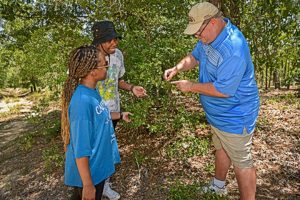 It’s hard to ignore the importance of bees to life on earth. Bees pollinate more than one-third of the human food supply, including a large majority of the fruits, vegetables and nuts in refrigerators and pantries.
It’s hard to ignore the importance of bees to life on earth. Bees pollinate more than one-third of the human food supply, including a large majority of the fruits, vegetables and nuts in refrigerators and pantries.
Pollinating bees are not just for growing food for humans, either. Seventy-five percent of all flowering plants on earth rely on pollinators to reproduce. These plants provide the foundation for countless food chains. Considering all that, it’s concerning that the primary commercial pollinator, the honeybee, is under significant threat from colony collapse disorder) and other factors.
According to a nationwide survey conducted by the nonprofit Bee Informed Partnership in 2021, beekeepers in the United States lost 45 percent of their managed honey bee colonies from April 2020 to April 2021. Biologists worldwide have expressed acute concern over this trend, which could have devastating consequences for the U.S. food supply if solutions aren’t found to reverse it.
Dr. Mark Schlueter, a professor of biology at Georgia Gwinnett College, has dedicated his life’s work to finding solutions to these problems. Initially focused on apple orchards, he shifted his research to blueberry patches after receiving an on-farm Sustainable Agriculture Research and Education research grant (SARE). Schlueter and his team planted wildflowers adjacent to blueberry patches on the Pinefield Eco Farm in Hephzibah, Ga., and will spend the summer observing the plants in detail.
Working with farm owner Zane Redman, Schlueter’s team planted three plots on one side of the farm consisting of four rows of blueberry plants with a row of wildflower plants to attract native bees. Three plots were planted without wildflowers on the other side of the farm. Video cameras, mounted on tripods, record native bee behaviors in both areas.
The study’s primary purpose is to discover if wildflower patches increase native bee abundance and diversity during the blueberry bloom period and, if so, which wildflower species best recruit native bees.
Floral enhancements on the edge of orchards and farms could lead to farms that only have to rely on native bees instead of using honeybee hives that are typically rented and placed on the farm. The recent losses in honeybee hives have significantly increased the cost of renting honeybee hives, which adds to production costs for farmers — costs that are passed to consumers.
Schlueter has been working with bees since 2010. In that time, he has been awarded eight SARE grants and done over 100 research presentations with students. He created a new course for the blueberry research project, BIOL 4570 Experimental Methods, that will give 10 students the opportunity to perform real-world bee research over the summer at the farm location.
Schlueter says this research is vital for many reasons:“Scientists estimate that bees contribute more than $15 billion in pollination services every year,” he said. “The honeybee is the main commercial pollinator and has been in decline since the 1970s. The best supplement or replacement for honeybees are native bees, and the best way to pull in native pollinators is to provide them with habitat enrichments.”
In addition, Schlueter says that boosting native bee abundance will also lower farmer expenses since they won’t need to rent honeybee hives for pollination. The better a crop can be pollinated, the better the yield. All of this leads to more food production for lower costs to the public and, more importantly, provides a backup plan for the potential loss of honeybees as pollinators.
Rogers Bridge work wins ASNE Project of Merit award
The Rogers Bridge project over the Chattahoochee River in Duluth earned the 2022 American Society of Civil Engineers Georgia Section Civil Engineering Project of Merit Award for the demolition of the 100-year truss.
Astra Group LLC collaborated with Heath and Lineback Engineers Inc. to remove and demolish Historic Rogers Bridge, built in the early 1900s over the Chattahoochee River. A 700-ton crane was used to execute the engineered critical lift. The removal made way for a replica pedestrian-friendly bridge to be constructed between Gwinnett and Fulton counties. The ASCE Georgia Section Project of Merit Awards are given to impactful projects showcasing contribution to communities, resourcefulness in planning and solving design challenges and innovations in construction and in the use of materials and methods.
The newly placed truss is the same 228’ in length as the original, with a similar design. However, the new model is significantly heavier weighing in at 287,000 lbs. The original truss was a mere 170,000 lbs in comparison. The truss was prefabricated and then welded and assembled on-site. Assembly took two weeks, and 47 tractor trailer loads of truss pieces. Once it was ready to be installed, an 825-ton Demag Crawler with 1.4 million lbs. of counterweights was required to safely move the massive structure into its final home over the Chattahoochee River.
- To see the placement of the bridge, check out this video. You might call this video a “swinging bridge”: Timelapse of Truss Install: https://youtu.be/d49SMhmytqk.
- Have a comment? Send to: elliott@brack.net










Follow Us